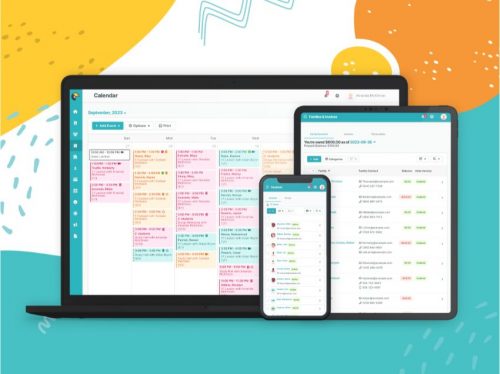Are you an independent online English teacher with a growing private tutoring business? Until now, you may have used free video-conferencing software and handled student management and administrative tasks on your own. But if your portfolio of students is growing, it may be time to find learning management software to assist with these tasks. Or perhaps you already have a flourishing online tutoring business and you’re ready to hire multiple tutors to manage a growing portfolio of students located all over the world.
Whether you’re an experienced independent ESL/EFL teacher with a staff or a new private tutor, there are many options for hosting a tutoring business. These days there are a variety of subscription-based LMS and learning platforms, each with different features and subscription options. A Learning Management System, or LMS, is software used to develop, manage and deliver instructional material. Options for e-learning platforms and learning management systems have grown as online and hybrid learning have expanded. These platforms are not only used in online teaching businesses but in traditional schools as well.

The online English language learning market has seen simultaneous growth in the private tutoring market and subscription-based LMS and learning platforms market. With so many options for virtual classrooms, student and administrative management tools and more, today’s private tutors, tutoring organizations and teaching businesses have a lot of choices.
My biggest advice to teacherpreneurs is to keep it simple. Start with a learning platform that is easy to manage and use.
The shift to cloud-based subscription models makes them accessible and affordable to small business owners. Some platforms are specifically designed for private language teachers or tutors, featuring more robust offerings of curricula and lesson content, multilingual support and language learning tools, while others are designed for businesses with multiple teachers or tutors, with more administrative features that may be more appealing to larger schools and tutoring organizations.
Before choosing a platform, it’s important to have a clear understanding of your unique needs and the features of the platforms you’re considering. For private ESL teachers or tutors with small businesses, the vast array of LMS and learning platform options can be overwhelming.
“My biggest advice to teacherpreneurs is to keep it simple,” said Anna Hearrell, Director of Teacher Training Products at Bridge. “Start with a learning platform that is easy to manage and use. The world of eLearning has grown so much, and new software/technological advances have exploded over the past few years. It is really easy to get distracted by ‘shiny object syndrome.’”
Choosing a platform is a big step. The first step is to conduct a needs analysis to determine your top priorities and growth strategy. “It is important to choose a platform that meets your immediate needs but also one that has the potential to grow with you and your business,” Hearrell said.
Before diving into some of the popular LMS and platforms for language teachers and tutors, let’s define some key terminology.
How do LMS and SaaS platforms differ?
In this discussion, the terms LMS and learning platform are used interchangeably, which is common. However, LMS are typically more comprehensive in their functionality, providing support for file sharing, data storage, collaboration features, etc. E-learning platforms typically focus more on hosting online courses, with some support for uploading content, file storage, etc. With the growth in the e-learning market, the lines between LMSs and learning platforms have become increasingly blurred. As a rule of thumb, LMSs remain the common system for large educational organizations.
SaaS refers to Software as a Service, a service offering cloud-based software, often white-labeled.
The SaaS model began in 1999 when Salesforce launched its customer relationship management (CRM) platform. Since then, it’s become increasingly popular. An LMS or e-learning platform may be SaaS, which is essentially a cloud and subscription-based software.

“SaaS refers to Software as a Service, a service offering cloud-based software, often white-labeled,” said Wilim Abrook, Head of Education and Community Development for LearnCube, a virtual classroom platform for language and tutoring companies. “LearnCube is one example. another example is Gmail – you can use their email software and don’t need to design and build your own.”
SaaS is a big umbrella that contains all software products that are paid as a subscription.
A non-SaaS LMS is hosted locally on the user’s server and requires an IT department to maintain and adapt software to the user’s needs. Self-hosted LMSs are usually open-source, allowing users to acquire the software and code needed to modify it. These features make LMS more suitable for schools than individual teachers because they need a dedicated team with the technical expertise to customize, update and maintain the system.
Because a SaaS platform is cloud-based, users pay a subscription and the provider handles the technical aspects. “SaaS is a big umbrella that contains all software products that are paid as a subscription,” said Xavier Moretti, Co-Founder of Koala Go, an interactive, gamified virtual classroom platform.
Koala Go is an LMS that is cloud- and subscription-based, Moretti said. Koala Go provides a virtual classroom, interactive tools and teaching resources, as well as management and administrative tools like scheduling, calendar, invoicing and online payments.
The bottom line is – different learning platforms and learning management systems may identify as an “LMS,” “learning platform,” “tutoring management software,” or other naming terminology. Each software offers different features, some more focused on instruction and others more focused on management and administration. Some offer “all-in-one” that prioritizes both. For individuals offering services as independent teachers or private tutors and those running small teaching or tutoring businesses, a cloud-based subscription model is likely the best solution.
Read about eight of the top eLearning platforms and LMS for English teachers.
Having a clear vision of your needs and goals
Whether the platforms you’re considering for your business market themselves as an LMS learning platform or other related terminology, each system will have different features and capabilities. Before choosing a learning platform, there is a lot to consider.
Some teachers or tutors may find great value in a platform with e-commerce features that will help with payment systems in certain countries, while others are looking for student management and scheduling systems to better serve their growing student portfolios. Still other teachers may want an interactive classroom and access to ready-made curricula and other teaching materials.

Let’s delve into some considerations that may help narrow the focus of your needs analysis. Consider these factors:
-
Interaction with students. Are your classes entirely online? Do you follow a hybrid system, or do you teach in person? This will affect your choice of learning platform. If you are physically meeting with your students, you won’t need a virtual meeting space. However, you may still want some of the options a learning platform offers, for example, a way of assessing students’ proficiency or a built-in curriculum. On the other hand, if you teach online or hybrid classes, you may want to avail yourself of features like an online booking system, electronic payments, a user-friendly interface as well as teaching materials tailored to your students’ needs. All of these features can often be provided by a single learning platform. Another aspect to consider is class size. Do you teach groups or one student at a time? Finally, where are your students located?
-
Your students’ needs. In analyzing your students’ needs, start by examining their goals. Why do they want to learn English? Develop their learner profile. What is their learning style? How do they learn best? What age are they? Adults and children have different needs. The answers to the above questions will affect your choice of lesson format and teaching tools and, consequently, the learning platform you operate on.
-
Your teaching style and preferences. Are you a sage on stage or a guide on the side? If your teaching style is student-centered, you can benefit from using a learning platform with interactive capabilities to communicate and collaborate with your students and have them interact with each other. If you like the flipped classroom approach, a learning platform offers options for students to work on the material on their own time. A learning platform with a good curriculum is a great tool for teachers who are pressed for time or don’t want to devote all their time to class prep.
-
Your goals and priorities. Consider your business format to establish your priorities and the direction you want to take your teaching business. Do you teach individual classes or groups? Some platforms will bill you based on class capacity, while others offer a flat fee subscription. Do you need marketing tools to recruit students, or do you contact students through a platform like Italki or Preply? If you teach large numbers of students, do you need scheduling software? Where are your students located? Do you need the ability to bill students overseas? Do you work alone? Do you already have a working business and are looking to expand?
-
Flexibility and potential for incorporating new features. A last aspect teachers should consider when shopping for an LMS or learning platform is the flexibility of the software. In the expanding online and technology-assisted education market, technological innovations are continuously being introduced. When selecting a platform, teachers should consider their capacity for integrating additional tools and incorporating new features.
Spending time thinking through these considerations will help you identify your priorities for your eLearning platform capabilities.
A lot of teachers start out using Zoom or Skype or video conferencing apps like that but quickly realize their limitations and want to find soemthing that allows the teacher to do more in the classroom.
Teacherpreneur Tim Gascoigne runs an online ESL teaching business and the OnlineTeacher Dude blog. As an experienced teacherpreneur, he also provides training and advice for English teachers looking to start private tutoring or teaching businesses.
“I think online teachers are specifically looking for something that is more developed towards teachers and students, rather than focused on meetings and conferences,” he said. “A lot of teachers start out using Zoom or Skype or video conferencing apps like that but quickly realize their limitations and want to find something that allows the teacher to do more in the classroom.”
Gascoigne went on to point out that an LMS or learning platform service differs in the additional features.
“I would say that the features that are important for teachers are the following: the ability to track progress, lessons, etc.; the ability to use a cloud-based system for storing files; ease of use for students and parents (onboarding is easy, seamless, etc.); a built-in web-based browser; screen sharing capability; and scheduling would be a plus, but not necessary.”
He added that a lot of teachers also look for “all-in-one platforms that can do payment, scheduling, etc…”
Many members of our Bridge community of teachers are private tutors and they are often looking for advice to find the best eLearning platform that will meet their varied needs.
As many teachers in the Bridge community are private tutors or teacherpreneurs with small businesses, some Bridge courses, articles, webinars, and other professional development resources provide insights into learning platform options and factors to consider when selecting a platform.
Bridge collaborates with LMS and learning platform companies TutorBird, Koala Go, and Classin, providing opportunities for the Bridge community to learn from insights shared by experts in this subject.
“Many members of our Bridge community of teachers are private tutors or run small online teaching businesses and they are often looking for advice to find the best eLearning platform that will meet their varied needs,” said Maggie de Oliveira, Bridge Teacher and Institutional Relations Manager. “Collaborating with eLearning solution providers helps Bridge identify the best products to meet our community needs.”
LMS or eLearning platform criteria to consider
Once you’ve completed your needs assessment and established your priorities for an LMS or learning platform, the next step is researching available platforms. Consider your prioritized needs. Do you need something affordable? Are you looking for a platform to meet administrative and management needs? Are white labeling and customization priorities? Or are ready-made learning materials a must-have?
With your priorities in mind, it’s helpful to identify criteria with which you can evaluate potential platforms. Some criteria to consider include:
-
What customization and white labeling options does it have?
-
What, if any, teaching resources are available?
-
What technology tools does it include?
-
What invoicing/payment tools are available?
-
How much teacher support is provided?
-
What are the pricing options?
Let’s consider some potential LMS and learning platform possibilities.
Struggling with setting your tutoring rates? Read What Am I Worth? Setting Rates as a Freelance English Tutor.
Examples of LMS and learning platforms
These platforms primarily cater to private tutoring and/or small teaching or tutoring businesses, with a few that also partner with large schools and organizations.
Koala Go
This cloud-based platform markets itself as “fun and collaborative.” The three primary features of Koala Go are the whiteboard, co-browser, and Playground. Fully customizable with white labeling capabilities, this platform is an excellent choice for private ESL tutors.
A lot of our users are ESL instructors, TESOL certified instructors who independently teach kids all over the world.
Xavier Moretti, Koala Go Co-founder described the interactive classroom feature as “Minecraft for teachers.” The platform is web-based and can be accessed from any browser. The co-browser is very popular with ESL teachers, Moretti said, as this screen-sharing feature can be opened to any content on the web. Playground – a Minecraft-style, interactive classroom – is very popular with students and parents, and features a variety of teaching tools like sticky notes, teacher controls and more.

For private tutors or small tutoring businesses, Teach With Koala, the administrative side of Koala, features course scheduling, invoicing, marketing features and the Koala Marketplace where teachers can purchase ready-made Playground activities or sell them. Koala has many teacher support options, ranging from how-to articles and videos to weekly live sessions with the co-founder and 24/7 live support for one-to-one training or technology questions.
“A lot of our users are ESL instructors, TESOL certified instructors who independently teach kids all over the world,” Moretti said. ESL teachers who want to maximize interaction with their students will find many useful tools in this platform. One unique feature, Moretti said, is “the co-browser that enables teachers to open a Marketplace activity directly from within the Koala classroom. The multisensory learning style of the activities makes them suitable for students with a variety of learning aptitudes.”

TutorBird
This tutor management software is primarily marketed to independent private tutors or owners of multi-tutor businesses. With TutorBird, tutors can manage their students, scheduling, billing, online tutoring and more from a single location. TutorBird includes student management, calendar tools, invoicing, online payments, learning management, marketing and business tools. It also includes options for multi-tutor businesses.
The flexibility of available options is what makes TutorBird stand out among other platforms.
“You don’t need to change how you run your business,” said Erin Ross, TutorBird Team Lead/Communications Specialist. ” You can set up TutorBird to work with your policies.”
Tutors can customize email and SMS templates for communications with students such as lesson reminders or overdue invoices. They can set registration and cancellation policies through the student portal. Calendar categories and locations can be customized, as can student billing options. Each student could be charged differently, and different billing settings can be applied per tutor if students take lessons with more than one.
TutorBird focuses on the business side of things, while you focus on the teaching content.
TutorBird will soon release a new website builder tool. Tutors can take advantage of this tool to build their own website and add a custom sign-up form or place the sign-up form on an existing website.
With its administrative and student management features, TutorBird is also an excellent option for private tutors.
“TutorBird focuses on the business side of things, while you focus on the teaching content,” Ross said.
TutorBird does not provide curriculum or lesson resources, but the platform has an Online Resources feature with unlimited overall space where any curriculum content or documents can be uploaded. After uploading, any content can be easily accessed and assigned to students.
Scheduling is one of the core features of TutorBird.
TutorBird integrates with many tech tools. For payment collection, Stripe and PayPal can be used, and tutors can set up Auto Pay. For online lessons, tutors can use Skype or FaceTime integration to call students from the calendar or Home Agenda. Virtual meeting links from conferencing apps like Zoom or Google Meet can be saved to join meetings from the calendar or Home Agenda. Students can also use the links to join from their calendars or from automatic lesson reminders.
TutorBird is also beta testing Zapier integration, which opens the ability to connect TutorBird with hundreds of other apps that use Zapier, Ross said.
The platform includes integrated scheduling as well. “Scheduling is one of the core features of TutorBird,” Ross said. “The powerful calendar tool allows you to create custom categories and locations, schedule private & group lessons, recurring lessons, etc.”
The calendar can be customized and synced to a third-party calendar of choice.
TutorBird provides a great deal of teacher support options, with a Customer Success Team that can be reached by phone or email, free group demos and 1:1 onboarding calls for new trials. There are also self-serve support options such as the Getting Started Guide, video tutorials, and hundreds of help articles available in-app or at support.tutorbird.com.
“TutorBird’s all-inclusive features at an affordable price point make it a great fit for independent private tutors, and our multi-tutor features (including payroll calculations and custom user privileges) make it work for tutoring businesses of all sizes,” Ross said. “The simple per-tutor pricing structure means TutorBird grows with your business without breaking the bank.”

Do you dream of traveling the world while running your private teaching business? Learn about the teach and travel lifestyle in the article From Teaching Abroad to Teaching Online: Rise of the Digital Nomad.
ClassIn
This one-stop solution is an LMS, with an interactive blackboard, cloud storage, assignments and grading. Marketed as the “best re-creation of a physical classroom online,” ClassIn is a product for independent teachers, tutoring businesses, K-12 schools and higher education. The platform offers solutions for both virtual and hybrid classrooms, making it suitable also for instructors who teach in person. ClassIn provides several attractive features for independent teachers.
The interactive virtual classroom has over 20 teaching tools including live chat, video gallery, polls, timers, a test bank and much more. The dynamic blackboard allows teachers to easily present the teaching material they have uploaded on the ClassIn cloud storage. Teachers also have access to curriculum in the ClassIn app and a new co-creation platform, TeacherIn, will be released by the end of October.
Teachers can assign activities and instantly check students’ progress, give students rewards, assign homework, receive notification for homework completed, correct the homework and leave comments for students. Additional tools provided by the virtual classroom are breakout rooms, screen-sharing tools and EBD templates. EBD files are graphic lesson files you create ahead of time to use on ClassIn’s blackboard feature. ClassIn’s EBD template collection saves teachers the time it would take to build individual EBD files.
Instructors have the flexibility to specify competencies and associate them with particular learning activities, ensuring targeted skill development.
On the administrative side, teachers can communicate with students and parents, take attendance, view learning reports and track students’ progress. ClassIn’s dashboard provides access to as many as 44 metrics to help teachers make informed decisions for instruction and feedback.
“Instructors have the flexibility to specify competencies and associate them with particular learning activities, ensuring targeted skill development,” said Sherry Zhu, ClassIn User Operations Director. Teachers can also “curate who can access specific learning activities, paving the way for tailored instructional experiences.”
Educators can not only define diverse grading types but also establish auto-grading protocols, streamlining the evaluation process.
ClassIn has many customizable features, including grading systems and student access.
“Educators can not only define diverse grading types but also establish auto-grading protocols, streamlining the evaluation process,” Zhu said. Teachers can also choose “whether to allow late submissions or permit students to download attachments, ensuring you have control over classroom materials and deadlines.”
ClassIn has integrated scheduling through in-app class and student management for teachers, which includes the ClassIn calendar. Teacher support is available through the ClassIn website, help center and Facebook communities.
While ClassIn is used by large educational institutions, the solution is marketed to independent teachers and tutoring organizations as well. For independent teaching and tutoring businesses scaling and expanding to include multiple teachers or tutors, ClassIn is an all-in-one LMS solution that provides integrated tools for all aspects of teaching and business.

LearnCube
This platform markets itself as a virtual classroom software for individual tutors, tutoring companies, traditional K-12 schools and corporations and large companies. LearnCube’s virtual classroom provides video conferencing, a whiteboard with an integrated content library and interactive tools, a conversation mode for text chats during lessons and video recording. LearnCube provides access to ESL lesson materials, and teachers can upload their own lesson materials.
The ideal LMS should be invisible to the student, so they just focus on their learning journey.
On the management side, LearnCube has class scheduling and reporting features. Tutors can schedule upcoming classes and sync with their calendars, and they can track attendance, minutes taught, past classes and more. The platform also allows white labeling, so tutors can brand their virtual classrooms with their own logos and colors.
“The ideal LMS should be invisible to the student, so they just focus on their learning journey,” Abrook said. “For teachers and school administrators, it should be easy to organize, manage and get reports.”
The LearnCube LMS is not designed for private tutors but for schools. The LearnCube virtual classroom software subscription, however, provides the integrated tools private tutors need to manage all aspects of the business side while providing a platform for seamless course delivery.
While many independent tutors may start their private tutoring business using video conferencing software, a virtual classroom like LearnCube is designed specifically for education, including the video conferencing elements along with education-specific features, Abrook said.
He has been teaching on the platform for six years and said he has seen his teaching experience change a lot as the platform and technology that enables it has developed. “I’m now excited to be in a position where I’m helping to shape the future of online education,” Abrook said, “especially with a platform that supports schools and tutors and really cares about being impactful.”
You don’t need to juggle lots of different windows and applications; it even includes a materials library so you have all the files you need right there when you need them.
LearnCube’s Virtual Classroom is an all-in-one platform, so all aspects of teaching and student management can be completed on the platform.
“You don’t need to juggle lots of different windows and applications,” Abrook said, adding that it “even includes a materials library so you have all the files you need right there when you need them.”
LearnCube provides tutor support through blogs, FAQs, how-to guides and topic-specific support pages. The combination of virtual classroom features and management solutions makes LearnCube a popular choice among private tutors.
TutorPage
This software is marketed as an “all-in-one” tutor management system. It is designed for growing tutoring businesses. The tutor management system provides scheduling for one-on-one and group lessons, coordinating time differences automatically for a global portfolio of students. TutorPage also provides online payment and invoicing for students all over the world. Clients can purchase courses from the teacher website created on TutorPage and pay online.
Tutoring businesses or companies can create a website on TutorPage or integrate the booking plugin with their existing website. TutorPage also provides additional marketing tools, such as website-building tools, a poster-generating system and social media share features. Teacher posters include the teacher’s name, an avatar, courses with prices, an introduction, a TutorPage ID and a QR code. Tutoring businesses can use these tools to showcase their portfolio of tutors.
TutorPage also provides automated administrative and communication tools. Tutor hours and earnings are calculated automatically through scheduling. Automatic lesson reminders can be sent. Lesson notes and process statuses can be recorded for streamlined communications with students. For tutoring businesses large and small, TutorPage provides effective tools to manage administrative and student management tasks.
Teachworks
This platform advertises itself as the No. 1 choice for managing a tutoring or teaching business. This platform is an excellent choice if your priority as an independent teacher is to facilitate all administrative and financial tasks.
“Teachworks offers modular design, allowing companies to enable features based on their specific requirements,” said Louise Germishuys, Design and Content Manager at Teachworks. “This provides our clients with a simple, uncluttered interface that improves efficiency.”
Among the tools provided is a sophisticated scheduling system that works through the calendar and allows teachers to instantly manage availability, make schedule changes, check scheduling conflicts and even change the duration of a lesson. Through the calendar, teachers can furthermore track detailed records for each lesson (attendance status, revenue, wage, teacher, students, location, and subject.) This multifunction on the teacher’s side is matched by the ability of clients to easily book, request, join and reschedule their own lessons.
Teachworks presents many helpful features to assist teachers in managing the finances of their independent businesses. Among those are several billing options, an invoicing system, payment reminders sent to students and online payment options. The platform also integrates with other finance managing tools.
“We currently offer more than 60 free integrations and add-ons,” Germishuys said. “Our most-used integrations include: Stripe for payment processing, QuickBooks Online for accounting, Lessonspace for conducting online lessons, and Zapier for task automation.”
Germishuys said Teachworks’ list of add-ons is extensive, but popular ones include:
-
A Website Booking Plugin to manage bookings on company websites
-
Custom Enrollment/Application forms to collect client and employee information (profiles are created automatically based on the details entered)
-
An API to build custom integrations
-
An Invoice Autopilot Add-on to automate the invoicing process
-
A Lesson Requests Add-on and a Customer Cancellation Add-on to allow customers to manage their own schedules
Teachworks features several tools to enable teachers to grow their business. One that stands out is the option to integrate a login form into one’s website through plugins. The integration allows teachers to display profiles of teachers and staff, let clients book or join classes directly from the website and create custom registration, enrollment and contact forms. In addition to the customization illustrated above, Teachworks offers white-labeling options, allowing teachers to display their logos on login pages, invoices and custom forms, and provides customizing software terminologies to match the company’s brand.
Teaching materials are not provided on this platform. So, if a platform with ready-made curricula or lesson activities is a priority, Teachworks may not be the right fit for you. But if you like to design your own lessons and simply need tools to present them, the platform features a virtual classroom, Lessonspace and an interactive blackboard within it.

Ready to learn more? Explore the free download, The Teacherpreneur’s Guide to LMS and Learning Platforms, featuring an analysis of 12 LMS and learning platforms as well as evaluation criteria and expert advice.
Making a decision
Choosing a learning platform is an important step that requires a great deal of reflection. A platform best suited to a teacher breaking into private tutoring for adult professionals may not meet the needs of an experienced teacherpreneur expanding an independent language institute that teaches children.
If you are just starting out as a private English tutor, you’re going to want a platform that is affordable and helps you check some initial boxes so that you can focus on teaching and marketing.
For teachers new to tutoring privately, eLearning platforms that are simple and affordable may be a good option, as they provide opportunities to grow business and management skills while building a student portfolio.
“If you are just starting out as a private English tutor, you’re going to want a platform that is affordable and helps you check some initial boxes so that you can focus on teaching and marketing,” Hearrell said. “This will ensure you dedicate your time to building customer relations and growing your student base. At its core, you’re going to want to find a platform that offers synchronous learning, curriculum and a robust support system.”
The platforms examined above are but a small sample of the available options. As you can see, each of these example platforms has certain features that meet differing needs. Identifying your needs and prioritizing them will help you choose the platform that will best meet your needs. For example:
-
If you’re looking for a fun, interactive, multisensory classroom, Koala Go may be your best option.
-
If you’re looking for student management and administrative tools in an all-in-one platform, TutorBird may be your best option.
-
If you’re expanding a tutoring business and looking for teaching tools and resources with an interactive blackboard for in-person, virtual, or hybrid classes, ClassIn may be your best option.
-
If you’re looking for an interactive virtual classroom and student management tools for private tutoring, LearnCube may be your best option.
-
If you’re looking for all-in-one management and administrative software for your tutoring business with multiple tutors, TutorPage may be your best option.
-
If you’re looking for administrative and management tools with an interactive classroom, Teachworks may be your best option.
Finding a learning platform is a big but exciting step for independent teachers launching or expanding an online tutoring or teaching business. Engaging in a detailed needs analysis, considering future needs, and researching platform capabilities will help you make an informed decision.










